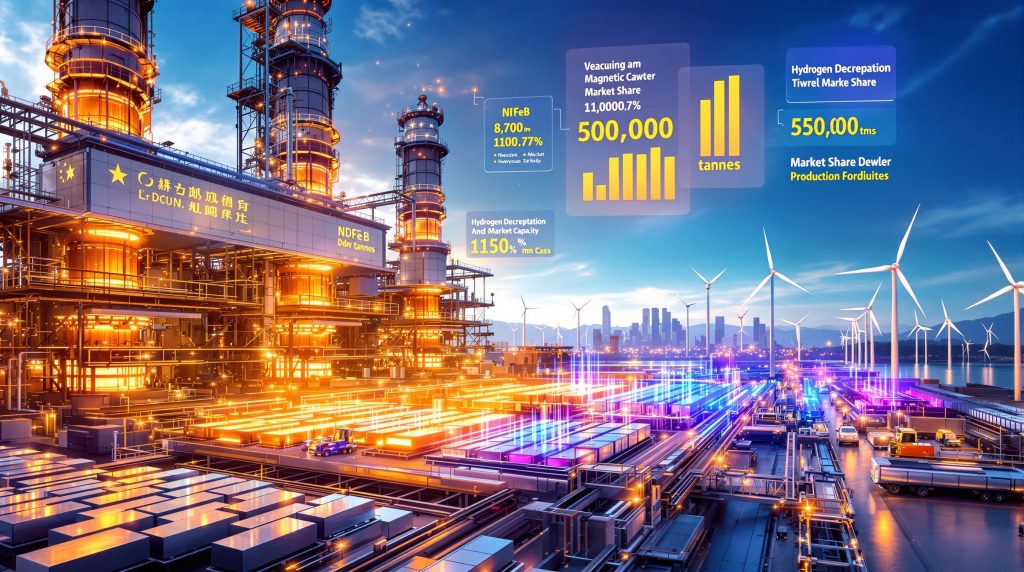Project Overview and Strategic Positioning
China Northern Rare Earth's ambitious 50,000-tonne China Northern Rare Earth NdFeB alloy project represents a pivotal expansion in global magnetic materials production capacity. This comprehensive project encompasses both primary alloy production and secondary processing capabilities, establishing new benchmarks for automated manufacturing in the rare earth sector.
Furthermore, the strategic positioning within China's broader rare earth processing ecosystem reflects coordinated industrial policy aimed at consolidating technological advantages in critical mineral supply chains. Manufacturing execution systems integration with automated material handling creates operational efficiencies that extend beyond traditional capacity metrics.
Table: China Northern Rare Earth NdFeB Project Key Metrics
| Metric | Details |
|---|---|
| Annual Capacity | 50,000 tonnes high-performance NdFeB alloy |
| Additional Output | 10,000 tonnes hydrogen decrepitation powder |
| Technology Focus | Rapid-solidification manufacturing |
| Automation Level | Full MES integration with AGV systems |
| Target Completion | Phase-1 operational by end-2024 |
Advanced Manufacturing Technologies Deployed
The production infrastructure incorporates multiple cutting-edge systems designed to optimise both throughput and quality consistency. Vacuum induction furnace technology enables precise temperature control essential for achieving superior magnetic properties in neodymium-iron-boron alloys.
The facility employs continuous vacuum induction systems achieving cooling rates exceeding 1,000 K/second, enabling superior magnetic properties compared to conventional processing methods.
Rapid-solidification processing represents a significant technological advancement over traditional metallurgical approaches. This methodology produces microstructural refinements that directly correlate with enhanced magnetic performance characteristics, particularly coercivity and energy product values crucial for high-performance applications.
In addition, integration of laser etching capabilities throughout the production line addresses growing traceability requirements from Western automotive and renewable energy manufacturers. Modern mining technology supports supply chain transparency mandates increasingly required by European Union regulations and American automotive quality standards.
How Does This Project Reshape Global Magnet Supply Chains?
The scale and technological sophistication of China Northern Rare Earth's NdFeB alloy project fundamentally alters competitive dynamics within global permanent magnet markets. Production capacity expansion of this magnitude influences pricing structures, quality benchmarks, and strategic sourcing decisions across multiple industrial sectors.
Production Scale Impact on Market Dynamics
China's dominance in rare earth magnet processing reaches approximately 90-95% of global capacity according to U.S. Geological Survey data. This single facility potentially represents 5-10% of worldwide NdFeB alloy production, creating both opportunities for economies of scale and concerns regarding supply chain resilience.
Market Position Changes:
- Creates among the largest single-unit rare earth magnetic materials facilities globally
- Establishes new benchmark for automated magnet alloy production
- Positions China to further consolidate global NdFeB processing capacity
- Reduces global dependency tolerance for smaller-scale Western operations
However, the facility's 50,000-tonne annual capacity operates within a market valued at approximately $13.6 billion according to Precedence Research analysis. This scale enables cost structures and operational efficiencies that challenge Western competitors seeking to establish alternative supply sources.
Technology Integration and Quality Assurance
Manufacturing execution systems coupled with automated guided vehicle integration represents a significant advancement in rare earth processing automation. These technologies improve yield stability, reduce contamination risks, and enhance batch-to-batch consistency critical for demanding applications.
The manufacturing approach combines multiple advanced systems:
- Manufacturing Execution Systems (MES) for real-time production monitoring and quality control
- Automated Guided Vehicles (AGVs) for material handling optimisation and contamination prevention
- Laser etching capabilities for comprehensive product traceability and serialisation
- Centralised control platforms linking all production processes for coordinated operations
Consequently, quality assurance improvements extend beyond traditional manufacturing metrics. Smart-factory integration enables comprehensive data collection throughout production cycles, supporting predictive maintenance protocols and process optimisation algorithms that reduce variability and improve overall equipment effectiveness.
What Are the Strategic Implications for Western Markets?
Western rare earth projects encounter intensified competitive pressures as Chinese manufacturing capabilities advance through automation and scale advantages. Market entry barriers continue rising as quality standards, cost structures, and customer relationship dynamics favour established suppliers with proven operational track records.
Competitive Pressure on Non-Chinese Projects
Western rare earth initiatives must overcome significant structural disadvantages including higher capital costs, extended development timelines, and the challenge of competing against vertically integrated Chinese operations with established customer relationships and supply chain efficiencies.
Western rare earth projects face intensified challenges as China's Northern Rare Earth accelerates its 50,000-tonne NdFeB facility, creating cost pressures and narrowing market windows for alternative suppliers seeking to establish competitive positions.
For instance, the United States imported approximately 100% of rare earth elements consumed in 2023, with China accounting for roughly 80% of imports according to U.S. Geological Survey data. Similar dependency patterns exist across European Union markets, where China provides 85-98% of rare earth imports depending on specific elements.
Automotive manufacturers including Tesla, BMW, and Volkswagen have publicly stated objectives to diversify rare earth magnet supply sources. Nevertheless, practical alternatives remain limited given the scale advantages and technological integration demonstrated by Chinese facilities like the China Northern Rare Earth NdFeB alloy project.
Quality Standards and Certification Requirements
Advanced manufacturing integration establishes higher benchmarks for quality assurance, serialisation, and supply chain auditability. Western automotive and renewable energy sectors increasingly demand comprehensive traceability capabilities that align with regulatory compliance requirements.
Smart-factory integration establishes higher benchmarks for quality assurance, serialisation, and auditability in areas increasingly demanded by Western automotive and renewable energy manufacturers.
Table: Competitive Advantages Created
| Advantage Category | Impact on Western Competitors |
|---|---|
| Cost Efficiency | Enterprise-wide cost controls pressure alternative supply curves |
| Production Speed | Accelerated commissioning reduces market entry windows |
| Quality Consistency | Automated systems improve yield stability and traceability |
| Market Responsiveness | Regionalised sales channels enable faster customer service |
ISO certification standards including ISO 9001 for quality management and IATF 16949 for automotive-specific requirements increasingly define market access criteria. The Northern Rare Earth facility's advanced automation capabilities position it advantageously for meeting these evolving certification demands.
Why Is This Project Critical to China's Strategic Planning?
The China Northern Rare Earth NdFeB alloy project aligns directly with China's national industrial policy objectives outlined in the 14th Five-Year Plan (2021-2025), while establishing foundations for the upcoming 15th Five-Year Plan period (2026-2030). Strategic mineral security and advanced manufacturing capabilities represent core priorities within these planning frameworks.
Dual Rare Earth Base Strategy Implementation
China's coordinated approach strengthens two complementary industrial hubs designed to optimise both domestic supply security and export competitiveness. The Baotou region focuses on integrated mining and primary processing operations, whilst coastal facilities emphasise advanced manufacturing and international market access.
China's approach centres on strengthening two primary hubs:
- Baotou operations (inland processing and mining integration)
- Coastal facilities (export-oriented manufacturing and logistics)
This geographic distribution strategy reduces transportation costs, optimises supply chain logistics, and creates redundancy within critical mineral processing infrastructure. The critical minerals energy transition reflects this coordinated industrial development approach.
Policy Window Utilisation
State-owned enterprise modernisation initiatives provide both financial support and regulatory flexibility for large-scale industrial projects. The timing of the Northern Rare Earth expansion capitalises on policy frameworks encouraging technological upgrading and manufacturing competitiveness enhancement.
Strategic Policy Alignments:
- State-owned enterprise modernisation and efficiency improvement initiatives
- Advanced manufacturing capability development and Industry 4.0 integration
- Critical mineral supply chain security enhancement and vertical integration
- Export competitiveness strengthening in high-technology sectors and value-added products
Moreover, State-owned enterprise reform emphasises digital transformation, cost management improvements, and supply chain consolidation according to State-Owned Assets Supervision and Administration Commission guidelines. The Northern Rare Earth project exemplifies these modernisation objectives through comprehensive automation and operational integration.
What Technologies Enable Rapid-Solidification Processing?
Rapid-solidification manufacturing represents a fundamental advancement in rare earth magnet production, enabling microstructural control that directly enhances magnetic performance characteristics. The technological infrastructure required for these processes demands sophisticated equipment integration and precise operational parameters.
Vacuum Induction Furnace Systems
Industrial-scale vacuum induction furnaces enable the precise temperature control and atmospheric management essential for high-quality NdFeB alloy production. These systems operate under carefully controlled conditions to prevent oxidation and maintain alloy composition integrity throughout the melting and solidification process.
Technical Specifications:
- Multiple high-capacity furnaces supporting continuous operation cycles
- Ultra-precise batching systems ensuring consistent alloy composition control
- Continuous operation capability designed for large-scale production requirements
- Integration protocols with downstream hydrogen decrepitation processing systems
Furthermore, cooling rates exceeding 1,000 K/second enable the formation of refined microstructures that enhance magnetic properties compared to conventional casting methods. This rapid-solidification approach produces superior coercivity values and improved temperature stability characteristics essential for demanding applications.
Hydrogen Decrepitation Powder Production
The facility's 10,000-tonne annual hydrogen decrepitation capacity supports downstream applications requiring specialised powder characteristics. This secondary processing stage involves controlled hydrogen exposure followed by vacuum annealing to achieve specific microstructural modifications.
The facility's 10,000-tonne annual hydrogen decrepitation capacity supports downstream applications in high-performance motors and advanced electronics manufacturing.
Hydrogen decrepitation processing enables particle size reduction and surface area enhancement critical for powder metallurgy applications. The controlled atmosphere and temperature cycling inherent in this process optimise magnetic domain structure and reduce coercivity losses associated with mechanical processing methods.
Consequently, integration between primary alloy production and secondary powder processing creates operational efficiencies and quality consistency advantages. Material flow optimisation reduces handling steps and contamination risks whilst enabling real-time quality monitoring throughout the production sequence.
How Does This Impact Global Electric Vehicle Supply Chains?
The automotive industry's transition toward electrification creates unprecedented demand for high-performance permanent magnets essential in electric vehicle powertrains. The China Northern Rare Earth NdFeB alloy project directly influences supply chain dynamics, pricing structures, and strategic sourcing decisions within the global automotive sector.
Automotive Industry Dependencies
Western automotive manufacturers currently source the majority of high-performance magnets from Chinese suppliers, creating strategic vulnerabilities as production scales increase and geopolitical considerations evolve. The International Energy Agency reports China controls approximately 85-90% of rare earth magnet processing capacity globally.
Western automotive manufacturers' reliance on Chinese magnet suppliers creates strategic vulnerabilities as production scales increase, with limited viable alternatives for high-volume, consistent supply.
Electric vehicle motor applications require magnets with specific performance characteristics including high energy product values, temperature stability, and corrosion resistance. The Northern Rare Earth facility's advanced processing capabilities directly address these technical requirements whilst providing the scale necessary for mass market automotive applications.
Tesla, BMW, and Volkswagen have publicly committed to diversifying rare earth supply sources through their sustainability reports and SEC filings. However, practical implementation faces challenges including limited alternative supplier capacity, quality certification requirements, and cost competitiveness considerations.
Wind Power and Renewable Energy Applications
Direct-drive wind turbine generators increasingly rely on permanent magnet technology to improve efficiency and reduce maintenance requirements. Offshore wind development particularly demands high-performance magnets capable of operating reliably in challenging environmental conditions.
Sector Implications:
- Offshore wind capacity additions averaged 10-12 GW annually from 2020-2023 according to Global Wind Energy Council data
- Direct-drive generator systems requiring higher-grade NdFeB alloys for improved efficiency
- Grid-scale energy storage applications expanding magnet demand beyond traditional sectors
- Solar tracking system motor applications increasing precision and reliability requirements
In addition, the Global Wind Energy Council forecasts continued growth at 8-15% annually through 2030, creating sustained demand for high-performance magnetic materials. Understanding rare earth reserves insights becomes crucial for assessing these expanding markets whilst establishing cost and quality benchmarks that influence competitive dynamics.
Renewable energy applications often require long-term performance reliability under varying environmental conditions. Advanced manufacturing processes including rapid-solidification and controlled atmosphere processing enhance magnet durability and temperature stability characteristics essential for these demanding applications.
What Are the Financial and Operational Metrics?
The Northern Rare Earth project represents significant capital investment within China's broader rare earth industry modernisation initiative. Financial metrics reflect both direct facility development costs and broader economic implications across related supply chain components and supporting infrastructure.
Investment Scale and Return Projections
Large-scale rare earth processing facilities require substantial upfront capital investment for specialised equipment, environmental controls, and automation systems. The Northern Rare Earth project's financial structure aligns with state-owned enterprise investment patterns supporting strategic industrial development objectives.
Table: Project Economics Overview
| Financial Metric | Estimated Value |
|---|---|
| Construction Timeline | 12-month primary build phase |
| Employment Creation | 200+ specialised manufacturing positions |
| Production Capacity | 50,000 tonnes NdFeB alloy annually |
| Secondary Processing | 10,000 tonnes hydrogen decrepitation powder |
Revenue projections depend on global NdFeB pricing dynamics, which fluctuate based on raw material costs, demand cycles, and competitive pressures. The facility's scale advantages and automation benefits position it to maintain profitability across varying market conditions whilst supporting strategic pricing decisions.
However, operational efficiency improvements through manufacturing execution systems integration reduce labour costs, minimise waste generation, and optimise energy consumption. These factors contribute to total cost of ownership advantages that enhance long-term financial sustainability.
Cross-Subsidiary Benchmarking Systems
Enterprise-wide performance management systems enable standardised operations across multiple facilities whilst identifying best practices and optimisation opportunities. This integrated approach supports continuous improvement initiatives and cost control objectives.
The company implements standardised metrics across subsidiaries including:
- Test methodology harmonisation ensuring consistent quality standards
- Process flow optimisation reducing cycle times and resource consumption
- Quality system alignment supporting certification and compliance requirements
- Research and development coordination maximising innovation impact and technology transfer
Furthermore, data-driven mining operations facilitate knowledge transfer between facilities whilst establishing performance targets that drive operational excellence. Data integration across multiple sites enables predictive analytics applications and strategic decision-making support at the enterprise level.
What Challenges Do Western Competitors Face?
Non-Chinese rare earth projects encounter multiple structural disadvantages that limit their ability to compete effectively against established Chinese producers with scale advantages, vertical integration, and government policy support. These challenges extend beyond simple cost considerations to encompass technology access, market development, and regulatory complexity.
Market Entry Barriers for Alternative Suppliers
Western companies seeking to establish rare earth processing capabilities face capital intensity requirements, extended development timelines, and the challenge of securing long-term supply agreements necessary to justify large-scale investments. Customer relationship development requires demonstrating consistent quality and delivery performance over extended periods.
Non-Chinese rare earth projects must overcome significant obstacles including higher capital costs, longer development timelines, and established customer relationships favouring Chinese suppliers with proven track records.
Technology transfer limitations and intellectual property considerations complicate Western efforts to achieve competitive processing capabilities. Chinese facilities benefit from decades of operational experience and continuous improvement initiatives that create knowledge advantages difficult to replicate in new operations.
Environmental permitting and regulatory approval processes in Western jurisdictions typically require longer timelines and higher compliance costs compared to established Chinese operations. These factors extend project development schedules and increase capital requirements for market entry.
Technology Transfer and Intellectual Property Considerations
Advanced manufacturing processes including rapid-solidification technology and automated control systems require specialised technical knowledge and equipment integration expertise. Chinese suppliers maintain technological advantages through research and development investments and operational experience.
Western companies seeking to compete must develop proprietary technologies whilst navigating intellectual property landscapes dominated by Chinese innovations in rare earth processing.
Equipment suppliers for rare earth processing often have established relationships with Chinese customers, creating potential conflicts of interest when supporting competing Western projects. This dynamic limits technology access and increases costs for alternative supply development initiatives.
Consequently, quality certification requirements for automotive and aerospace applications demand extensive testing and validation procedures. New Western facilities must establish performance track records whilst competing against Chinese suppliers with existing certifications and customer approvals.
How Will This Affect Rare Earth Pricing Dynamics?
Supply-demand balance shifts resulting from large-scale capacity additions influence pricing structures across multiple rare earth market segments. The Northern Rare Earth facility's production scale creates both opportunities for cost reduction and potential market concentration concerns affecting long-term price stability.
Supply-Demand Balance Shifts
Increased Chinese production capacity may moderate price volatility whilst potentially creating deflationary pressure on rare earth magnet pricing. Market participants must evaluate whether demand growth from electric vehicles and renewable energy applications will absorb additional supply capacity.
If China Northern Rare Earth achieves full 50,000-tonne capacity whilst global demand grows at current rates, pricing pressure on alternative suppliers could intensify within the next two years, though actual outcomes depend on multiple market variables.
Price discovery mechanisms within rare earth markets reflect complex interactions between raw material costs, processing margins, and end-user demand patterns. Large-scale facility additions alter these dynamics by changing cost structures and competitive positioning across the supply chain.
Transportation costs, trade war impact analysis, and currency exchange rate fluctuations influence pricing relationships between Chinese suppliers and international customers. The Northern Rare Earth facility's scale may provide greater flexibility in managing these external factors.
Long-term Contract Implications
Strategic sourcing decisions increasingly emphasise supply security and quality consistency over pure cost minimisation. The Northern Rare Earth facility's advanced automation and quality control capabilities position it advantageously for long-term supply agreements with demanding customers.
Procurement Strategy Changes:
- Western OEMs may increasingly seek longer-term supply agreements for price and volume predictability
- Price volatility could decrease due to increased supply stability and operational consistency
- Quality premiums for non-Chinese sources may increase as differentiation becomes more difficult
- Strategic stockpiling by consuming nations likely to accelerate as supply concentration increases
Contract terms evolution reflects growing importance of traceability, environmental compliance, and social responsibility considerations within supply chain management. The Northern Rare Earth facility's advanced systems address these requirements whilst maintaining competitive pricing structures.
However, risk management strategies for rare earth procurement must balance cost optimisation with supply security objectives. Large-scale Chinese capacity additions may reduce short-term supply risks whilst potentially increasing long-term dependency concerns for Western consumers.
What Are the Geopolitical Implications?
The Northern Rare Earth project reinforces China's dominant position in global rare earth supply chains whilst Western nations pursue diversification strategies through alternative supply development, recycling technology advancement, and strategic stockpiling initiatives. These dynamics create complex interdependencies with significant economic and security implications.
Critical Mineral Security Considerations
National security frameworks increasingly recognise rare earth dependency as a strategic vulnerability requiring coordinated policy responses. The Northern Rare Earth facility's scale advantages potentially complicate Western efforts to achieve supply chain resilience objectives through domestic or allied nation capacity development.
The project reinforces China's position in global supply chains whilst Western nations pursue diversification strategies through:
- Domestic mining development initiatives in Australia, Canada, and the United States focusing on alternative deposit development
- Alternative processing capacity establishment in Malaysia, Vietnam, and India supported by Western investment and technology transfer
- Recycling technology advancement for urban mining applications and end-of-life product recovery systems
- Substitution research programmes aimed at reducing rare earth dependency through alternative materials and design approaches
Critical mineral stockpiling programmes in the United States, European Union, and allied nations reflect growing recognition of supply chain vulnerability. Nevertheless, the scale and cost advantages demonstrated by facilities like the Northern Rare Earth project complicate the economics of alternative supply development.
Trade Policy and Export Control Responses
Export control mechanisms and trade policy tools provide potential levers for managing rare earth dependency, though their effectiveness depends on alternative supply availability and economic cost considerations. The Northern Rare Earth facility's advanced capabilities may influence policy calculations regarding trade relationship management.
Expanded Chinese production capacity may influence Western trade policies regarding critical mineral import dependencies and domestic supply chain resilience requirements.
Technology transfer restrictions and foreign investment screening mechanisms increasingly focus on critical mineral supply chains. The Northern Rare Earth project demonstrates Chinese capabilities in advanced manufacturing technologies that may influence Western policy approaches to technology sharing and industrial collaboration.
Furthermore, multilateral coordination mechanisms including the Minerals Security Partnership and similar initiatives reflect recognition that individual nation responses may be insufficient to address rare earth supply chain challenges. The scale advantages demonstrated by Chinese facilities like Northern Rare Earth may accelerate these coordination efforts.
Strategic Outlook for Global Rare Earth Markets
The China Northern Rare Earth NdFeB alloy project represents a significant milestone in global rare earth market evolution, establishing new benchmarks for scale, automation, and operational integration. Market participants must adapt strategies to address changing competitive dynamics and supply chain structures.
Short-term Market Dynamics (2024-2026)
Accelerated commissioning timelines create immediate competitive pressures whilst establishing operational benchmarks that influence industry standards for automated production and quality control. Market participants must evaluate strategic positioning relative to these enhanced capabilities.
Manufacturing execution systems integration and automated quality control establish higher performance standards that may become industry requirements for automotive and aerospace applications. Western suppliers must invest in comparable capabilities to maintain market access and competitive positioning.
In addition, supply chain efficiency improvements through vertical integration and operational optimisation create cost advantages that influence pricing dynamics across multiple market segments. Alternative suppliers face increased pressure to demonstrate comparable value propositions through differentiation strategies.
Long-term Industry Transformation (2026-2030)
Market consolidation trends may accelerate as scale advantages and technological capabilities increasingly determine competitive success. The Northern Rare Earth facility exemplifies the capital intensity and technical sophistication required for market leadership in rare earth processing.
Table: Projected Market Evolution
| Timeline | Key Developments |
|---|---|
| 2024-2025 | Phase-1 production begins, immediate supply increase |
| 2025-2026 | Full capacity achievement, pricing pressure intensifies |
| 2026-2028 | Western alternative projects face increased competition |
| 2028-2030 | Market consolidation around major producers |
Technology advancement trajectories including automation, quality control, and environmental performance will increasingly define market access requirements. The Northern Rare Earth facility's integrated approach provides a blueprint for next-generation rare earth processing capabilities.
Consequently, geopolitical considerations will continue influencing supply chain decisions as nations balance economic efficiency with strategic security objectives. The scale and capabilities demonstrated by the Northern Rare Earth project may accelerate Western efforts to develop alternative supply sources whilst highlighting the challenges inherent in achieving competitive positioning against established Chinese operations.
For further analysis of China's rare earth market dominance, China Northern Rare Earth modernization provides comprehensive insights into ongoing technological developments. Additionally, industry participants can explore China's rare earth supply chain strategies for detailed market positioning analysis.
This analysis contains forward-looking statements and projections based on current market conditions and announced development plans. Actual outcomes may vary significantly due to market dynamics, regulatory changes, technology developments, and geopolitical factors. Readers should verify current information and consult qualified professionals before making strategic or investment decisions.
Further Exploration:
Industry participants seeking comprehensive analysis of rare earth market developments can access additional research through specialised trade publications, government mineral resource agencies, and professional associations that provide ongoing coverage of this rapidly evolving sector.
Looking to Capitalise on Rare Earth Market Opportunities?
Discovery Alert's proprietary Discovery IQ model delivers instant notifications when significant mineral discoveries are announced on the ASX, helping investors identify actionable opportunities in critical minerals including rare earth elements. With China's dominance in rare earth processing creating supply chain tensions and Western nations seeking alternative sources, explore Discovery Alert's track record of identifying major mineral discoveries that could reshape global supply chains. Start your 30-day free trial today to position yourself ahead of market-moving announcements in this rapidly evolving sector.




